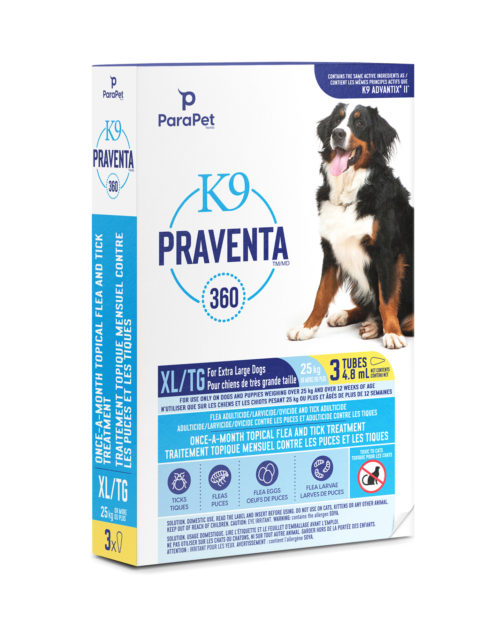If you have a dog, you know that a flea infestation is the last thing you want to deal with. But what can you do to avoid one in the first place? And what do you do if your dog already has fleas?
Fleas are small, wingless bloodsucking insects that feed off the blood of their hosts, which include both humans and pets. They are the most common external parasite that affects dogs. Fleas are prolific breeders – a single female can lay up to 50 eggs in a day, so it’s easy to understand how an infestation can quickly get out of hand.
THE FLEA LIFE CYCLE
The flea life cycle is made up of 4 stages: Eggs, Larvae, Pupae and Adults.
Eggs
The beginning of the flea life cycle, eggs are laid on the pet and can fall onto the floor or other surfaces as your dog moves around. A female can lay 2,000 eggs in her lifetime, which can take up to two weeks to hatch. Eggs make up approximately 50% of an infestation.
Larvae
The larval stage is next after the eggs have hatched. Flea larvae thrive in dark, damp environments and feed on flea dirt (pre-digested organic debris passed through adult fleas). Larvae account of 35% of the flea population in your home.
Pupae
Pupae make up 10% of the flea population in your home. Flea larvae spin silk-like cocoons, creating a sticky shell that protects them as they develop into adulthood. This process takes one to two weeks, but adult fleas will remain in their cocoon (for weeks or even months) until a host is close enough for them to jump on.
Adult Fleas
Hard to believe, but adult fleas make up only 5% of the flea population in your home. An adult will jump on your pet to lay eggs. Females require blood from their host to do this, which is what leads to skin irritation and itching and scratching. Not only can flea bites cause discomfort they can also transmit diseases such as flea allergy dermatitis and tapeworm.

HOW DO YOU KNOW IF YOUR DOG HAS FLEAS?
Is your dog scratching more than usual? Excessive scratching could be a sign that your pet has fleas.

Other signs that could indicate a flea infestation are:
- Your dog nibbles and bites particular spots on its body
- You notice red or irritated spots on your dog’s skin
- Your dog has bald patches where it’s been scratching or licking excessively
- You see flea droppings (that look like specs of dirt) or eggs (white specs) on your pet or bedding, carpet, floors and other areas your pet frequents
BREAKING THE FLEA LIFE CYCLE
So, your dog has fleas… now what? Following these simple steps to treat an infestation will put you on the right track to being flea-free:
1. Treat your pet
If you find fleas on your dog, getting rid of them should be a top priority. Start by using a fine-tooth flea comb to remove fleas. Follow up with a bath using a pet safe soap or shampoo.
Applying a monthly topical treatment that kills fleas on contact is the most efficient way to eliminate them. Unlike oral medications, which work only once your dog has been bitten, K9 Praventa 360 not only repels and kills adult fleas on contact – meaning no biting required – but it affects each flea life stage, continuing to work by preventing flea eggs and larvae from developing.
Keep in mind that if you have more than one pet in the house, it’s a good idea to treat them too.
And always check with your vet to be sure that your dog’s scratching isn’t a symptom of something else.

2. Treat your home – indoors and out
It isn’t enough to simply treat your dog for fleas, keeping your home free of these pests is also important. Fleas can quickly spread throughout the home. If you’ve discovered fleas on your dog, it’s most likely that your home is also infested with them. So, what can you do to eliminate them?
Vacuum, vacuum, vacuum
Vacuuming surfaces such as carpets and hardwood floors as well as upholstery, curtains, and any place your dog likes to sleep will suck up any fleas that have fallen from your pet regardless of life stage. And, the heat of the vacuum will also help kill fleas, pupae in particular.
Remember to empty the canister or throw out the bag in an outdoor garbage can after you’ve vacuumed to prevent fleas from escaping and eggs from hatching inside the vacuum cleaner.
Wash everything
Wash ALL bedding – your pet’s and yours – as well as pillows, area rugs, blankets, and clothes in HOT, soapy water. Fleas can’t survive temperatures of 35ºC or higher, no matter the life stage and adding laundry detergent to the hot water makes the treatment even more effective. Follow by throwing everything in the dryer at the hottest setting.
3. Treat your yard
Finally, it’s not just the interior of your home that needs attention. Spray your yard with an outdoor flea and tick spray to kill any flea populations that may be hiding in the yard and around the foundation. Mowing the lawn regularly will help keep fleas away as will keeping the yard clear of leaf piles and litter such as branches and leaves.
PREVENTION EQUALS PROTECTION
Examining your pet regularly coupled with using a monthly flea and tick preventative is key to avoiding and controlling a flea infestation, helping to keep your pet and your home flea-free.




